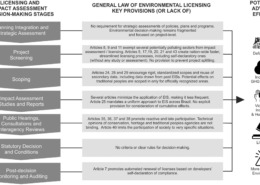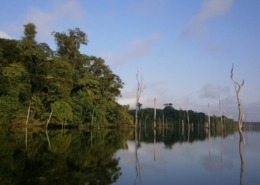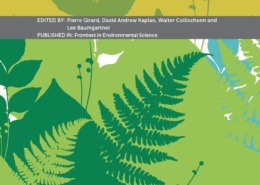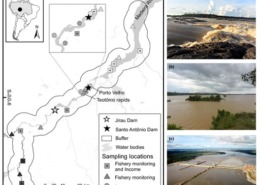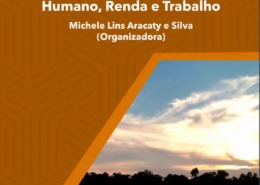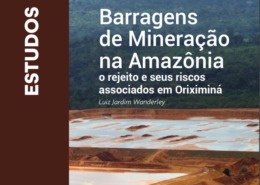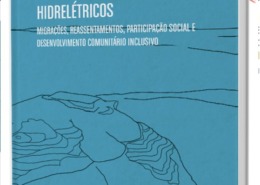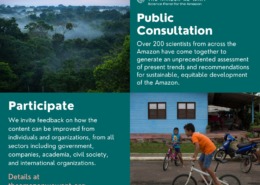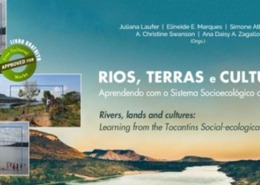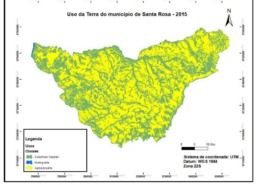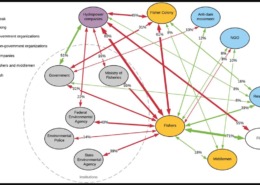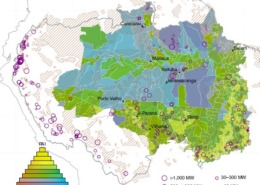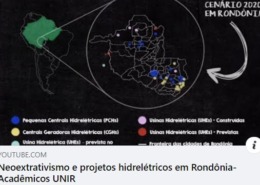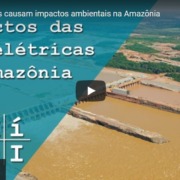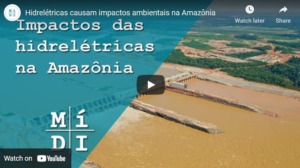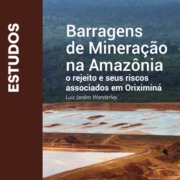The impacts of hydroelectric dams on Amazonian artisanal fisheries from the perspective of socio-ecological systems
O artigo “Os impactos das barragens hidrelétricas na pesca artesanal amazônica sob o olhar dos sistemas socioecológicos”, com autoria de Ramos Júnior e outros, foi publicado na Revista Ibero-Americana de Ciências Ambientais. Os autores observaram que o sistema pesqueiro da região amazônica foi afetado pela construção de barragens hidrelétricas. A pesquisa mostrou ainda que a defasagem de informações sobre os impactos ambientais causados por essas construções pode comprometer o desenvolvimento das medidas compensatórias. Roteiro: Juliana Rocha Gravação e edição: Roni Lima
The article “ The impacts of hydroelectric dams on Amazonian artisanal fisheries from the perspective of socio-ecological systems ”, by Ramos Júnior and others, was published in the Revista Ibero-Americana de Ciências Ambientais. The authors noted that the fishery system in the Amazon region was affected by the construction of hydroelectric dams. The research also showed that the lack of information about the environmental impacts caused by these constructions can compromise the development of compensatory measures.
Link to full article: https://doi.org/10.6008/CBPC2179-6858.2020.006.0018
Link to video: https://youtu.be/eVJ-zF7OjKM
Ebook: Regional Development in the Amazon: Infrastructure, Human Capital, Income and Work
Desenvolvimento Regional na Amazônia: Infraestrutura, Capital Humano, Renda e Trabalho
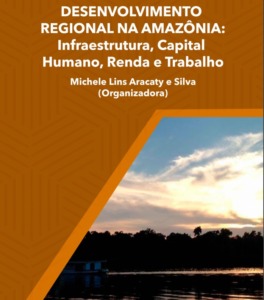 Apresentamos esse livro que reúne trabalhos de vários pesquisadores e tem como objeto de estudo o Desenvolvimento Regional no contexto amazônico. Este e-book completa um projeto de publicação colaborativa entre um grupo de pesquisadores e amigos, inclusive de instituições amazônicas parceiras da RBA. Este faz parte de uma coletânea juntamente com os outros dois e-books anteriormente publicados, que são: AMAZÔNIA: Desafios e Perspectivas para o Desenvolvimento Regional (2014) e AMAZÔNIA: Aspectos Singulares para o Desenvolvimento Regional (2019), este livro intitulado: DESENVOLVIMENTO REGIONAL NA AMAZÔNIA: Infraestrutura, Capital Humano, Renda e Trabalho, apresenta como característica principal a composição por artigos científicos construídos por docentes, discentes, pesquisadores e amigos que discutem em seus estudos e pesquisas temas ligados à temática do livro. Este e-book assim como os demais trabalhos deste grupo tem o seu acesso livre para pesquisas e leitura de forma a ser um objeto de compartilhamento de informação e conhecimento agregado acerca dos temas aqui abordados. Desejamos uma excelente leitura e reflexão acerca dos artigos aqui compartilhados.
Apresentamos esse livro que reúne trabalhos de vários pesquisadores e tem como objeto de estudo o Desenvolvimento Regional no contexto amazônico. Este e-book completa um projeto de publicação colaborativa entre um grupo de pesquisadores e amigos, inclusive de instituições amazônicas parceiras da RBA. Este faz parte de uma coletânea juntamente com os outros dois e-books anteriormente publicados, que são: AMAZÔNIA: Desafios e Perspectivas para o Desenvolvimento Regional (2014) e AMAZÔNIA: Aspectos Singulares para o Desenvolvimento Regional (2019), este livro intitulado: DESENVOLVIMENTO REGIONAL NA AMAZÔNIA: Infraestrutura, Capital Humano, Renda e Trabalho, apresenta como característica principal a composição por artigos científicos construídos por docentes, discentes, pesquisadores e amigos que discutem em seus estudos e pesquisas temas ligados à temática do livro. Este e-book assim como os demais trabalhos deste grupo tem o seu acesso livre para pesquisas e leitura de forma a ser um objeto de compartilhamento de informação e conhecimento agregado acerca dos temas aqui abordados. Desejamos uma excelente leitura e reflexão acerca dos artigos aqui compartilhados.
O E-book pode ser acessado pelo link: https://www.atenaeditora.com.br/post-ebook/3064
******
Regional Development in the Amazon: Infrastructure, Human Capital, Income and Work
We present this book that brings together papers by several researchers and has as its main object of study the Regional Development in the Amazon context. This e-book completes a collaborative publishing project between a group of researchers and their friends, including RBA Amazon institutions partners. This is part of a collection along with the other two previously published e-books, which are: AMAZÔNIA: Challenges and Perspectives for Regional Development (2014) and AMAZÔNIA: Unique Aspects for Regional Development (2019), this book entitled: DEVELOPMENT AMAZON REGIONAL: Infrastructure, Human Capital, Income and Work, has as its main characteristic the composition of scientific articles written by professors, students, researchers and friends who discuss in their studies and research some themes related to the topic of the book. This e-book, as well as the other papers of that group, has free access for research and reading with the aim to be an object for sharing information and aggregated knowledge about the topics covered here.
We wish you an excellent reading and reflection on the articles shared here.
The E-book can be accessed through the link: https://www.atenaeditora.com.br/post-ebook/3064
Ebook: Mining Dams in the Amazon: Tailings and Associated Risks in Oriximiná
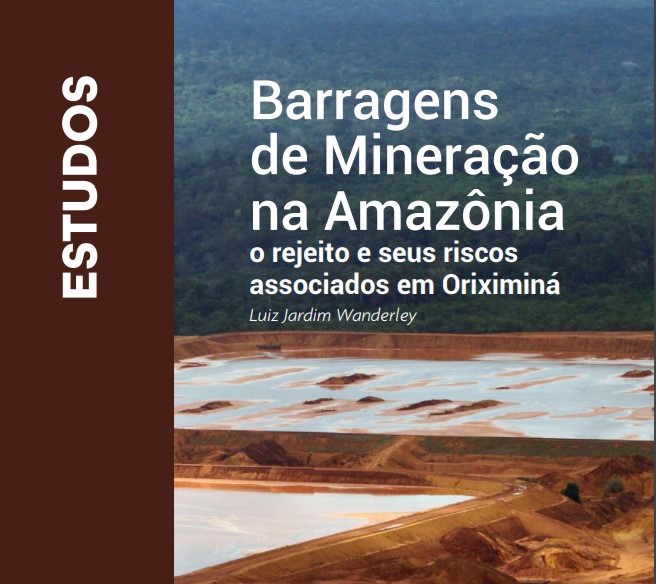
BARRAGENS DE MINERAÇÃO NA AMAZÔNIA: O REJEITO E SEUS RISCOS ASSOCIADOS EM ORIXIMINÁ
Autor, Luiz Jardim Wanderley
Apresentamos este livro recentemente publicado, que é parte de um número de uma coletânea de estudos voltados a impactos em território amazônico. O objetivo dessa edição é tornar a realidade das barragens de mineração de Oriximiná (Pará-Brasil) mais conhecida e melhor compreendida, além de contribuir com o debate mais amplo sobre os custos socioambientais da mineração na Amazônia. A grandiosidade do empreendimento e a gestão dos rejeitos produzidos pela maior produtora de bauxita do Brasil, da Mineração Rio do Norte (MRN), que há 41 anos extrai o minério no interior do Pará, no município de Oriximiná, se reflete nas estruturas necessárias para armazenar os rejeitos que ficarão para sempre na Amazônia, numa área que já foi floresta nativa. São 26 barragens de rejeito já instaladas, uma em construção e, ao menos, mais dez novas previstas. Um debate importante, pois assim como as barragens hidrelétricas, as de minérios se instalam a cada dia no território amazônico e os custos socioambientais se repetem.
O E-book pode encontrado no link: https://cpisp.org.br/…/SerieEstudos_BarragensMineracao.pdf
***
MINING DAMS IN THE AMAZON: TAILINGS AND ITS ASSOCIATED RISKS IN ORIXIMINÁ
Author, Luiz Jardim Wanderley
We present this recently published book, which is part of a collection of studies focused on impacts in the Amazon territory. The objective of this edition is to explore the reality of the mining dams in Oriximiná (Pará-Brasil) and make it better known and better understood, in addition, to contribute to the broader debate on the socio-environmental costs of mining in the Amazon. The grandiosity of the project and the management of the tailings produced by the largest bauxite producer in Brazil, Mineração Rio do Norte (MRN), which for 41 years has been extracting ore in the interior of Pará, in the municipality of Oriximiná, which is reflected in the structures necessary for storage of the scraps that will remain forever in the Amazon forest, in an area that was once native forest. There are 26 tailings dams already installed, one under construction and at least ten new ones planned. It is an important debate, because like hydroelectric dams, mineral dams are installed every day in the Amazon territory and the socio-environmental costs are repeated.
The E-book can be found at the link:
https://cpisp.org.br/…/SerieEstudos_BarragensMineracao.pdf

